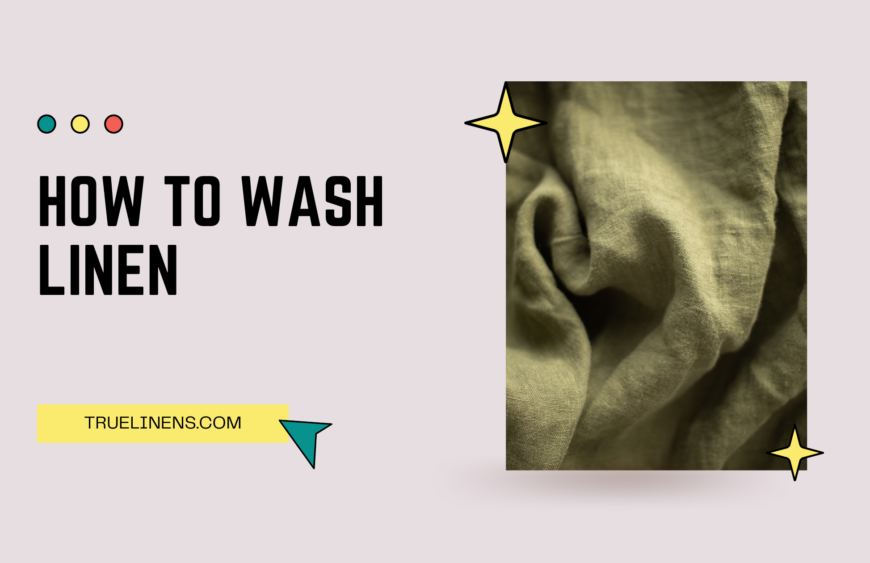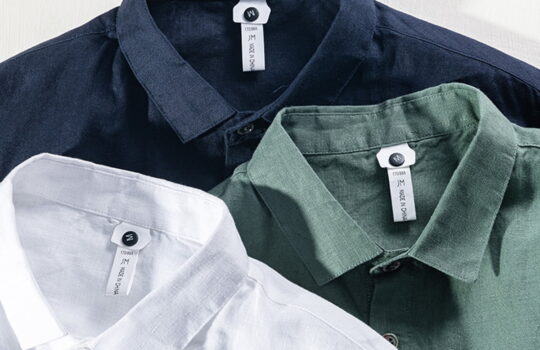Linen is heralded for its durability and grace under the variable climates of life, offering breathable comfort with an air of effortless sophistication. Could there be an art to caring for such a fabric?
Care for your linens.
Ensuring the longevity and aesthetic appeal of your linen garments hinges on adopting meticulous washing practices that respect the fabric’s unique qualities.
Understanding Linen Fabric
Linen, derived from the fibers of the flax plant, is distinguished by its natural luster and inherent strength, characteristics that make it an enviable choice for both casual wear and formal ensembles. This textile is valued for its exceptional coolness and freshness in hot weather, attributed to its high absorbency and conductivity. Appreciating the textile’s structure and properties is crucial, as it informs the tailored care that linen demands to maintain its distinctive charm and functional elegance over time.
Linen’s Unique Qualities
Linen fabric is renowned for its breathability and extraordinary tensile strength, optimizing comfort and durability in apparel.
Prized for centuries for its natural sheen, linen fabric ages gracefully, becoming softer and more lustrous with each wash.
As a hypoallergenic natural fiber, linen is kind to sensitive skin and possesses inherent moisture-wicking properties, making it an ideal choice for all climates, enhancing the wearer’s well-being.
In the sphere of sustainable fashion, linen stands out—citing a lower environmental footprint than many counterparts—thus aligning seamlessly with eco-conscious consumer values and eliciting a profound respect for nature.
Pre-wash Tips for Linen
Before laundering your linen garments, always check the care label for any specific instructions from the manufacturer.
It is paramount to segregate your linens, separating colored from light and dark fabrics to prevent any color transfer during the wash. Linen is susceptible to abrasion; hence, it’s advisable to turn the garments inside out to protect their surfaces. Employing a mesh laundry bag for smaller items not only prevents tangling but also cushions the fabric from excessive wear in the washing machine’s rigorous cycle.
Additionally, ensure that all zippers, buttons, and fastenings are secured to avoid snagging other items in the batch. Pre-treating any stains is wise, but it must be executed with delicacy, using products specifically formulated for linen to avoid compromising the fabric’s integrity.
Finally, it is crucial to avoid overloading the washing machine when cleaning linen. The fabric requires ample room to circulate and release dirt and oils effectively. If too tightly packed, the aggressive rubbing of the textiles can lead to unnecessary stress on linen fibers, diminishing the material’s longevity and potentially causing permanent creasing.
The Washing Process
When embarking on the washing cycle for linen, one must respect the fabric’s natural delicateness. Choose a mild, linen-friendly detergent, and set your washing machine for a gentle cycle with lukewarm water, ideally at 30°C (86°F), to preserve the fibers’ strength and color vibrancy. Employ a moderate spin speed to lessen the wrinkle formation intrinsic to linen. It’s imperative to avoid the use of bleach, as it can break down the linen fibers and result in irreparable damage. Furthermore, abstain from pouring detergent directly onto the linen; instead, distribute it evenly within the water before placing your garments in the machine. This method ensures a uniform and gentle cleansing, safeguarding your linen’s pristine condition and longevity.
Choosing the Right Detergent
Selecting an appropriate detergent is paramount for maintaining linen’s inherent beauty. Opt for a mild, liquid formulation that’s gentle on fibers.
Since 1950, the fabric care industry has seen remarkable advancements in detergent formulations. Now, specific detergents cater to the needs of linen, enhancing the fabric’s durability and appearance.
Today, the choice abounds with detergents boasting eco-friendly credentials, hypoallergenic properties, and fabric-enhancing enzymes. For linen, it’s best to choose a product that’s free from harsh chemicals and is designed to work at lower temperatures.
When using a chosen detergent, adhere to dosage guidelines. Overuse can lead to residue buildup on linen fibers which can compromise the material’s breathability and soft texture.
It is through conscientious detergent selection that one can ensure the proper care and longevity of their linen wardrobe. The right choice keeps linen feeling fresh and looking impeccable for years to come.
Machine vs. Hand Washing
The decision between machine and hand washing linen hinges on the fabric’s care label instructions.
Machine washing, with its efficiency and convenience, often emerges as the preferred method for many linen garments. Provided the care label permits, this option can save time without compromising the integrity of the fabric.
However, hand washing linen can be seen as a more delicate approach, preserving the fabric’s natural texture and longevity. This method can prevent the harsh agitation that sometimes occurs in washing machines, thus protecting your linen.
When opting for machine washing, it’s essential to select a gentle cycle and ensure the load is not overcrowded. It allows linen the space to move freely, reducing the risk of wrinkling and stress on the fibers.
For those who favor the meticulous nature of hand washing, use lukewarm water and a gentle swishing motion to clean the linen, avoiding any rigorous scrubbing or twisting.
Drying Linen Correctly
Linen’s inherent resilience is best maintained by air-drying, ideally laid flat on a clean, dry surface or hung on a clothesline away from direct sunlight. This natural method mitigates the potential for the fabric to become overly brittle or lose its shape, preserving its structural integrity and aesthetic appeal. To prevent any lasting creases, gentle reshaping of the garment while damp is advisable.
When using a tumble dryer, it’s crucial to set it to a low heat and a gentle tumble cycle. The linen should be removed promptly when it is still slightly damp, which helps in easing ironing and minimizes the chance of over-drying that could compromise the fabric’s softness and durability.
Best Practices for Drying Linen
Proper drying is essential to maintain linen’s texture and longevity.
- Air-Dry When Possible: Spread the linen garment flat or hang on a clothesline to dry naturally.
- Avoid Direct Sunlight: Place linen in a well-ventilated area out of direct sunlight to prevent fiber damage.
- Tumble Dry on Low: If using a dryer, choose a low heat setting and remove the linen while slightly damp.
- Reshape While Damp: Before drying, gently reshape the garment to minimize wrinkles and maintain form.
Linen’s charm lies in its natural crinkles; however, care in drying can reduce excessive wrinkling.
While machine drying is permissible, air-drying is quintessential for preserving the fabric’s splendid characteristics.
Common Drying Mistakes
Many mistakenly subject their linen to high heat in a dryer, inadvertently accelerating wear and compromising its structural integrity.
Excessive wringing out can lead to distorted fibers and a loss of shape.
Overloading the dryer can result in uneven drying and persistent wrinkles, counteracting linen’s aesthetic appeal.
Similarly, leaving linen in the dryer for too long exposes it to unnecessary heat, increasing the likelihood of shrinkage and loss of softness.
Some even forgo the pre-drying garment reshaping, not realizing this crucial step helps maintain linen’s silhouettes and prevents stubborn creases.
Finally, the neglect of prompt removal from the dryer often leads to set-in wrinkles, necessitating arduous ironing or steaming to rectify.
Ironing and Storage Techniques
When ironing linen, one must approach with a delicate hand, considering the fabric’s propensity for sheen when over-pressed. It is recommended to iron while the material is still slightly damp, using a medium-hot iron and swift, decisive strokes to achieve a crisply smooth surface. A pressing cloth may also be employed to safeguard the linen’s texture and prevent any potential glossiness.
Proper storage is crucial to maintaining the integrity of linen garments. Linens should be stored in a cool, dry place, away from direct sunlight that could potentially fade the fabric. For optimal preservation, fold the items gently, avoiding sharp creases that could mar the fibers, or hang them on padded hangers to keep their shape pristine.
Achieving Wrinkle-Free Linen
Precision in laundry care is fundamental.
Linen, a material revered for its breathability and durability, does indeed have a natural tendency to wrinkle. This is often misinterpreted as a flaw when, in fact, it’s an intrinsic characteristic of this esteemed textile. However, meticulous washing and care can mitigate the formation of wrinkles, thus enhancing the garment’s aesthetic. Carefully adjusting washing machine settings and promptly removing linen items after the cycle can dramatically reduce creasing.
Use distilled water to dampen your linen before ironing.
Drying linen flat prevents the formation of deep-set wrinkles. While tumble drying can be an option, always ensure to use a low heat setting and remove the linen while it’s still ever so slightly damp. This retention of minimal moisture is crucial – it facilitates easier ironing and achieving a wrinkle-free appearance.
Hang or lay flat immediately after ironing to maintain smoothness.
Utilizing a high-quality steam iron, specifically one with adjustable temperature settings, will significantly enhance the linen’s appearance. When wielded with expertise – ensuring the iron gently glides over the fibers without excessive pressure – one can produce a suitably sleek finish that aligns with linen’s elegant disposition.
Experts recognize the importance of harnessing the latest laundering technologies to maintain linen’s luster. Considering the rise of innovative laundry solutions, expected in the market by 2023, these advances promise a new era in fabric care. Garments treated with these pioneering techniques can exhibit a polished appearance, exemplifying the convergence of timeless fabric with contemporary precision in garment care.
Storing Linen to Maintain Quality
To protect linen’s integrity, a dry, cool environment devoid of direct sunlight is optimal for storage. Ensuring proper ventilation prevents moisture accumulation and fiber degradation.
Avoid plastic containers; they can trap humidity. Opt for breathable cotton storage bags instead.
When folded neatly, linen can maintain its form, but overpacking shelves or drawers may lead to persistent creases that challenge the fabric’s natural resilience. Allow space for air to circulate, deterring mold or mildew development and preserving the textile’s pristine condition.
For garments that benefit from hanging, padded or wooden hangers are recommended to sustain shape and drape. Absent of sharp edges, such hangers avert potential snagging, stretching, or warping of the fibers. Moreover, hangers should not be overly bulky or laden with metal components that could potentially imprint or oxidize onto the fabric. In cases of long-term storage, the use of acid-free tissue to buffer folds can prevent creasing and provide an additional layer of protection against environmental aggressors.
FAQ: How to Wash Linen
Linen is a delicate fabric that requires special care when it comes to washing. In this FAQ, we answer some common questions about how to properly wash linen clothing.
-
Q: Can I machine wash linen?
A: Yes, you can machine wash linen, but it’s important to use a gentle cycle and cold water to prevent shrinking and damage to the fabric.
-
Q: Should I use bleach when washing linen?
A: No, it’s best to avoid using bleach when washing linen as it can weaken the fibers and cause discoloration. Instead, opt for a mild detergent.
-
Q: Can I tumble dry linen?
A: While linen can be tumble dried, it’s recommended to air dry it to prevent excessive wrinkling. If you choose to tumble dry, use a low heat setting.
-
Q: How should I iron linen?
A: To iron linen, set your iron to a medium-high heat and iron while the fabric is slightly damp. This will help to remove wrinkles effectively.
-
Q: Can I dry clean linen?
A: Dry cleaning is not necessary for most linen clothing. However, if the care label recommends dry cleaning, it’s best to follow those instructions.
Remember, always check the care label on your linen clothing for specific washing instructions, as different garments may have different requirements.






